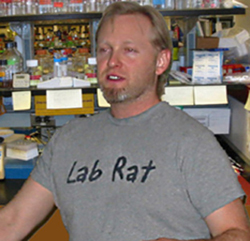 Research in
the Thompson laboratory uses chemical
biology to examine molecular
recognition events inside the cell. How do
protein–protein
and protein–DNA interactions discern between different binding
partners? By
studying
the structural and energetic factors that determine specific protein
interfaces,
we will understand how the assembly and disassembly of these complexes
define
biology. Specific questions our lab focuses on include; how small
chemical modifications
of histone proteins control DNA accessibility to turn genes on and off,
and
using our knowledge of molecular recognition to design miniature
proteins that
affect gene regulation.
Research in
the Thompson laboratory uses chemical
biology to examine molecular
recognition events inside the cell. How do
protein–protein
and protein–DNA interactions discern between different binding
partners? By
studying
the structural and energetic factors that determine specific protein
interfaces,
we will understand how the assembly and disassembly of these complexes
define
biology. Specific questions our lab focuses on include; how small
chemical modifications
of histone proteins control DNA accessibility to turn genes on and off,
and
using our knowledge of molecular recognition to design miniature
proteins that
affect gene regulation. We are very interested in understanding the detailed mechanisms by which proteins 'read' chemical modifications, such as methylation or acetylation. We hope to draw direct correlations to discreet chemical modification patterns on histone proteins with biological function. The elusive Histone Code Hypothesis. As we begin to understand the detailed mechanisms by which proteins 'read' chemical modifications and the connection to cellular expression profiles, we expect to apply this knowledge to the development of non-native recognition surfaces leading to controlled expresion of select genes.
The Thompson Lab performs many techniques common to biochemistry and molecular biology, including excising genes of interest from human and yeast genomes for controlled expression using "bacterial production facilities", (ie. we put the gene into E.coli, which makes our proteins for us). Consequently, we have all the instruments, equipment and facilities necessary for cloning genes of interest, expressing protein products and performing in vitro analysis using a variety of steady-state and time-resolved fluorescence techniques.
Additional areas of expertise in the lab are: Protein and DNA chemistry. Solid-phase peptide synthesis of native and highly modified peptides. Synthesis of small molecules/fluorophores. Molecular biology techniques, yeast genetics and fluorescence microscopy. Fluorescence spectroscopy (fluorometry)